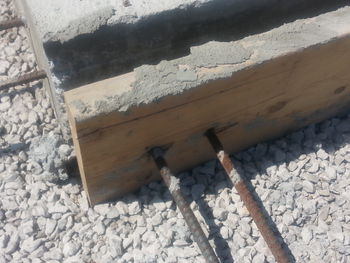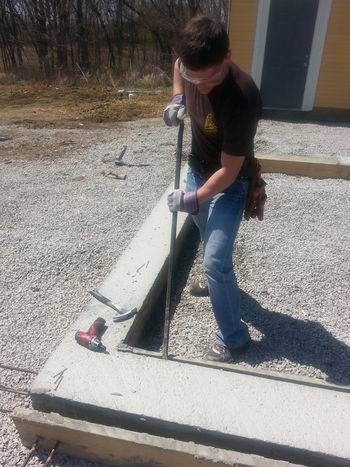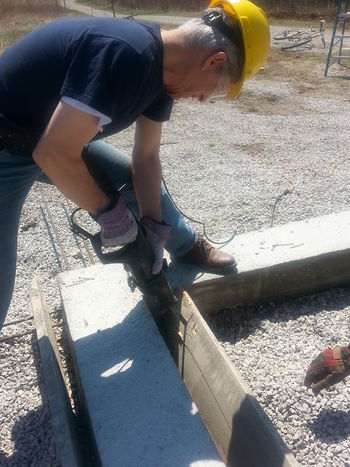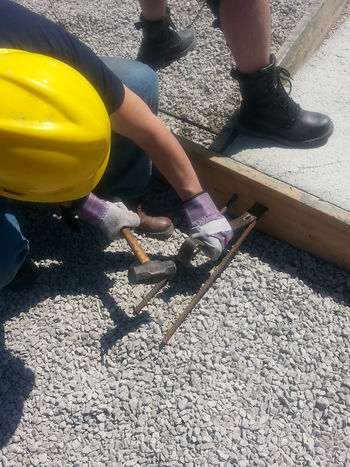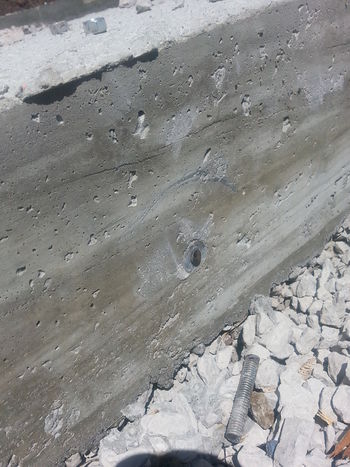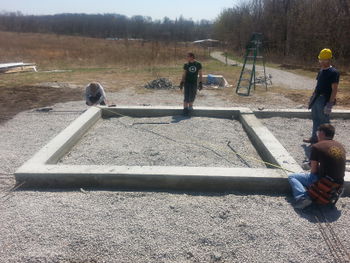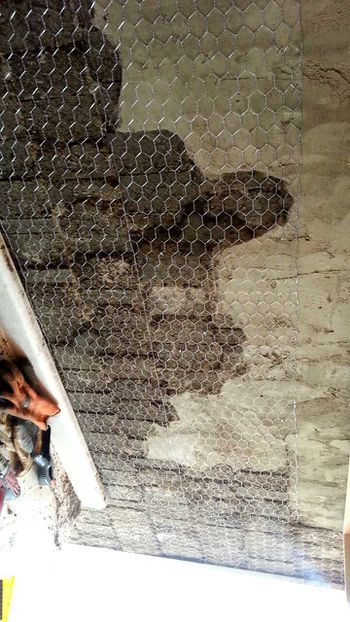Kyle log
Saturday, April 19
Friday, April 18
Chris (Chris Log) picked me up from the Cameron Greyhound station at 8:50, and we made our way straight to the FabLab.
Introductions to new visitors - getting workshop cleaned up for Microhouse roof modules.
Microhouse 2 Foundation Work
List of duties completed
1) Removal of horizontal foundation framing members (use crowbar,scrap 2X4 for leverage, sawzall & jigsaw when needed)
2) Cut/flush threaded 3/8" bolts from foundation
3) Check level
Removal of horizontal foundation framing with primarily crowbar. Under certain conditions, mostly in corner areas, or areas of overlapping, other methods of removal are used such as the use of a sawzall or the use of a wedge to split the board in half - allowing for the rebar to slide out of the edge.
After removing all the horizontal support frames, the 3/8" bolts, used to secure the supports, need to be removed and smoothed with a grinder.
After all support structure has been removed, and all 3/8" bolts have been removed, cross-measurements are taken to ensure the foundation is square. After measuring two diagonals, the following measurements resulted:
1st angle measurement: 238 1/4"
2nd angle measurement: 236 7/8"
Chris Log will discuss how a 'target' measurement will be achieved by the end of construction:
Target measurement: 237 1/2"
Thursday, April 17
I am leaving tonight for Factor E Farm for the Microhouse Workshop.
My schedule for reference
Greyhound bus from Indianapolis, IN to Cameron, MO 4/17/14
- from Indianapolis - 10:15 p.m.
- from St. Louis - 3:10 a.m.
- from Kansas City - 8:00 a.m.
- arrive at Cameron - 8:50 a.m.
Greyhound bus from Cameron, MO to Indianapolis, IN 4/23/14
- from Cameron - 6:20 a.m.
- from Kansas City - 8:25 a.m.
- arrive at Indianapolis - 7:45 p.m.
Thursday, March 13
Last workday at OSE - finishing up at micro house and FabLab
Wednesday, March 12
Further plastering to be done at the Micro house. When making many batches of plaster (gypsum/perlite & water), try to obtain a consistency similar to peanut butter. Another note: Don't be afraid to put a thick layer of plaster on - 1/4" or so. My first assumption was that I would just need to scrape the trowel against the wall as I applied the plaster in a thin layer, just to fill all the crevices. But applying a thicker layer allows for flatter surfaces with less cracks.
Before applying a second layer, lightly spray the first coat with water to ensure an appropriate bonding.
Partial wall - earth brick/chicken wire/gypsolite
Tuesday, March 11
Plaster work was done at the Micro house. I learned how to mix the gypsum/perlite with water to make plaster at a proper consistency. Prior to plaster, chicken wire was secured to the earth brick walls with staples and nails.
White wash was applied to the exterior of the FabLab. Prior to the application, mud was applied to smooth the exterior surface. We had issues with the mixture cracking on the second batch of mix and a test was done to determine what criteria of the mix were most crucial. It was discovered that a water spray was necessary to ensure the white wash would stick to the original wall. Making sure the mixture was thin enough and applied with a proper brush is critical for proper its quality.
Monday, March 10
HabLab design works The design team of our group considered the placement of both the front deck of the FabLab, as well as the gravel road to lead from the front entrance by the workshop to the FabLab. There is an existing road from the main road to the FabLab, however Marcin has requested an alternative solution.
- Cost and benefits were considered for the existing road:
The benefits of keeping the existing road to the FabLab would be easy access for deliveries and other accessibility situations. The negatives of keeping the existing road are unwanted visitors and safety concerns.
- Cost and benefits were considered for the extension of the main entrance to the FabLab:
The benefits of extending the main road would be the ability to remove the path from the main road to the FabLab completely. The negatives of extending the existing road to the FabLab would be extra costs in terms of material costs, and the cost of removing and replacing the water line that would interfere with the gravel path extension. There would be grading issues that would need to be resolved for truck access. The FabLab roof also would obstruct access.
- Solution/result
The path from the main road to the FabLab will be removed and the extra space will be used for agricultural production. The existing road well be extended towards the FabLab, but will not be extended to it. Any deliveries well be unloaded before the culvert and transported to the FabLab by dolly truck or other means.
Designs for the summer camp were considered for further use of the hexiyurt as a pavilion for campers.
Sunday, March 9
- Critically considering alternative framing process than enables both earth-brick stacking and continuous roof framing simultaneous - while ensuring
1) Safety of all workers
2) Quality of roof
3) Speed of construction
